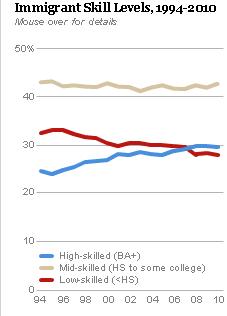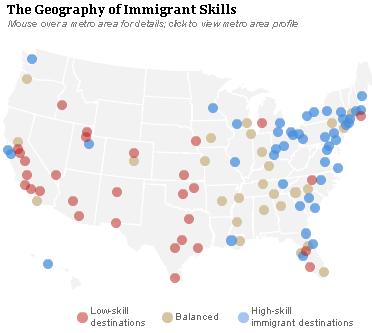Katrin brought our attention to a report from the Brookings Institution about the educational levels of immigrants to the U.S., based on data from the 2009 American Community Survey as well as Census data between 1900 and 2000. As a group, immigrants have significantly more education than common stereotypes might lead you to believe. In fact, there are now more immigrants with at least a 4-year college degree than with less than a high-school diploma (27.8%):
Overall, immigrants still have lower levels of education than native-born U.S. citizens. While the proportion with a college degree is comparable (32% of the native-born and 29.6% of immigrants have a 4-year degree or higher), the immigrant population is much more likely to have less than a high school diploma (27.8% vs. 7% for the native-born).
The proportion of immigrants falling into the high- or low-education categories varies significantly by destination city. The study authors calculated the ratio of high-skill to low-skill immigrants (where skill is defined as education level, as in the graph above) for the 100 largest metro areas. High-skill destinations have more than 125 college-educated immigrants per 100 immigrants with less than a high school diploma; low-skill cities have fewer than 75. A city was defined as “balanced” if there were between 75 and 125 high-skill immigrants per 100 low-skill immigrants.
A map of the ratios shows that of the 100 largest metro areas, those in the eastern half of the U.S. (especially the Northeast) attract more educated immigrants, while the Great Plains and West (especially California, Arizona, New Mexico, and Texas) have lower-educated immigrant population. Balanced-skills cities are concentrated in the Midwest and Southeast:
Not surprisingly, cities with universities attract more highly-educated immigrants, while those with economies based on agriculture or food processing are more likely to be destination sites for immigrants with less education.
Here’s a video of one of the authors, Audrey Singer, discussing the study and its implications:
You can also see the detailed information about the 100 largest metro areas. In the areas studied here, immigrants with less than a high school diploma are disproportionately from Mexico (57.3%, but with wide geographic variation — Mexican immigrants make up only 6.2% of low-skill immigrants in Buffalo but 85.8% in Austin), lack English skills (only 16.4% are proficient), and are unlikely to be naturalized citizens (26.2%). Among immigrants with a college degree, 5.5% are Mexican, 71.5% are English-proficient, and 54% are naturalized citizens. The full report has a detailed discussion of the factors at play here–historical immigrant settlement patterns, changes in which cities are gateways for arriving immigrants, and so on. If you’re interested in immigration issues and how they impact economic development, it’s definitely worth a read.



Comments 8
Yrro Simyarin — July 5, 2011
This isn't unexpected, as having a college degree and a job already lined up puts you on a much faster track to legal immigration than pretty much anything else. Few people outside of the IT industry are complaining about bringing in Indian and Chinese PHD's.
But skilled and unskilled immigration have very different ramifications for the country. Even if you are someone like me, who supports open borders (or at least more open than the current farcical system) you have to deal with the social, political, and economic consequences of increasing the general unskilled labor pool.
That said, most of the Mexican immigrants I've met (legal and illegal) could teach Americans a few things about how to live with a low income. When you're pulling in 50 cents over minimum wage at Wendy's and still manage to send half of your paycheck home to your family south of the border, it puts a very different spin on the term "living wage."
Gilbert Pinfold — July 5, 2011
We could deconstruct this report a little, instead of leaving it deliberately obscure. Not only are the conclusions obscure but they are slightly circular, or question begging. Thus:
"Recent immigrants to metro areas with the fastest-growing immigrant populations have markedly lower educational attainment than immigrants settling elsewhere."Is this not bureaucratic-academic waffle for 'Immigrants are not what they used to be. Unless they are the high achieving East and South Asian groups headed to SF, Boston and other yuppie hubs.'
Anonymous — July 6, 2011
Your post implies that there are not universities in the cities with red dots. We do have universities in Texas and the south. Several exist in Houston, Austin, Dallas etc. In fact, I'm fairly certain that UT Austin is one of the largest universities in the country.
CynthiaC.M. — July 7, 2011
The education rate is very interesting. In Canada, immigrants are MORE likely to be better educated. However, they're also more likely to be unemployed.
http://www.statcan.gc.ca/daily-quotidien/070910/dq070910a-eng.htm
Shanta Brown — December 4, 2020
The title of this article is Regional Variations in Educational Levels of U. S. Immigrants.The article is about the education levels og high, middle,and low skilled immigrants.These graphs are based on a reoport from the Brookings Intitute based on data from the 2009 American Commmunity Survey as well as the Census data between 1900 and 200.The first graph represent how much educationeach group of immigrants has. For example, 32% of the native-born citizens and 29.6% of high-skilled immigrants have earned Bachelors degreesor higher and 27.8% haveless than a high school diploma..You can also see detailed information about the100 largest metro areas.On the map, you can see the geography of Immigrant skills for each group. 27.8% of low-skilled workers have less than a high school diplomas. 32% of native born citizens and 29.6% of high-skilled workers have a Bachelors degree or higher.Immigrants from each category will be able to find work according to their skill level and where they live.